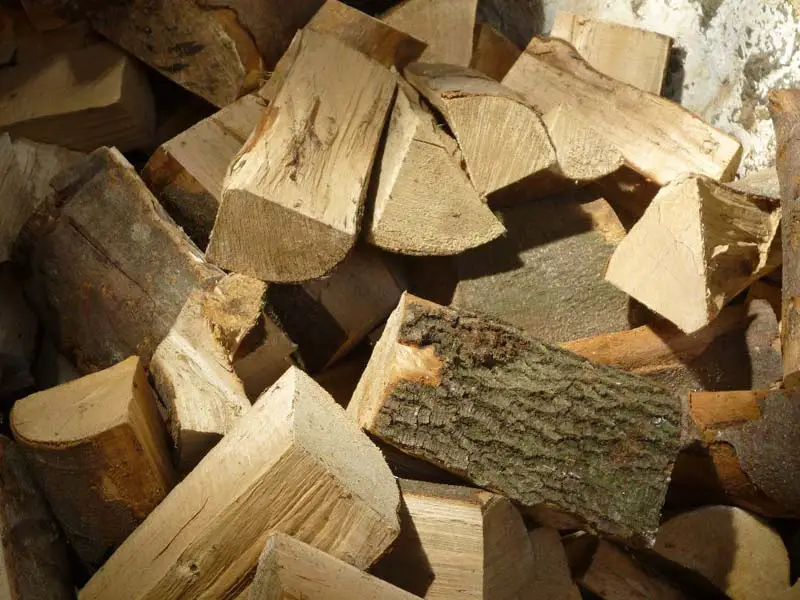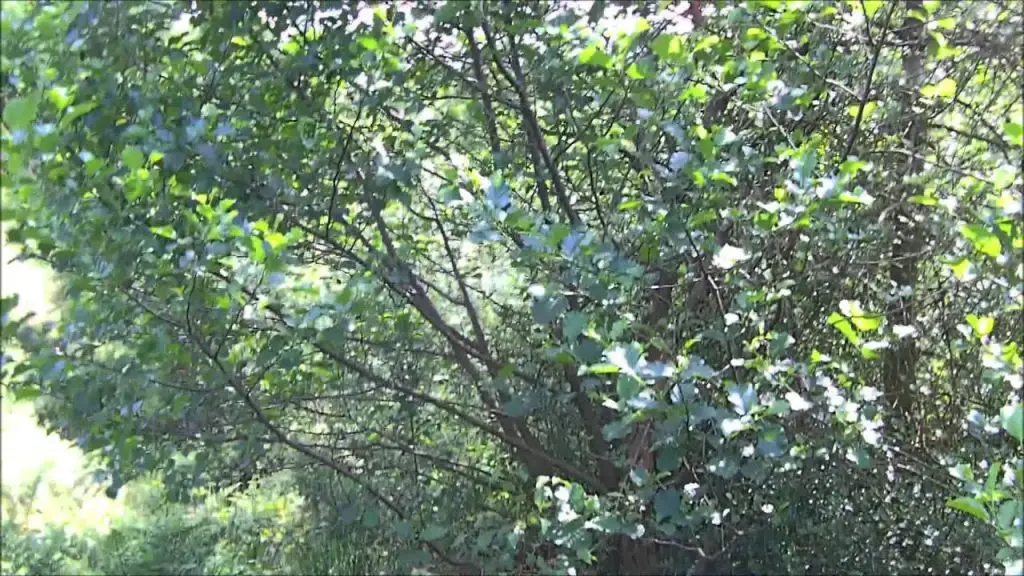Alder is fair firewood because of its lower BTU and faster burn time but it is easy to split and seasons quickly. It is widely available, which makes it cheaper than alternative firewoods.
Because alder grows quickly and is readily available where it grows, it may be a great budget-friendly option to add to your woodpile.
Along with this, alder is a lighter hardwood, so you can easily transport it after dried if need be.
Overall, alder is a favorite among some because it is easy to use, split, and grow – making it a cheaper option of firewood compared to other hardwoods.
Table of Contents
Summary
- BTU: 17.5 million
- Weight: 2540 lbs. per dry cord
- Seasoning Time: 6-8 months
- Splitting: Easy
- Smoke: Low
- Smell: Pleasant
Alder trees are hardwood trees that are a member of the birch family. The most common alder species is the red alder which grows on the west coast of North America. The second most commonly found alder is the black alder, which is native to Europe.

Heat Production
British Thermal Unit, or BTU, measures the heat produced from any source. You will also see this unit of measurement on air conditioners, space heaters, and gas firepits. Alder produces 17.5 million BTUs per cord.
Even though alder is a hardwood, it acts more like a softwood in that it lights easily and burns hot and fast. Alder has a lower BTU compared to other popular hardwoods.
Alder firewood burns fast but creates a relatively hot fire and leaves behind decent coals. The fast-burning pace causes alder firewood to be favorable in the fall and spring when outside temperatures are moderate.
Because alder has a fairly loose grain pattern, alder will light quickly, which is excellent if you need or want a fire right away.
Moderate outside temperatures will also help you conserve your alder firewood since you will burn through it quicker than other hardwoods. Mixing alder with other hardwoods such as oak can also help with this.
Alder is used to produce impressive quality lump wood charcoal, which is fantastic to BBQ with.
Smoke Production
Green Alderwood will produce tons of unpleasant and unbearable smoke and a large quantity of ash, so only to burn seasoned alder.
However, alder will create only a small amount of smoke once seasoned.
Alder does produce a moderate amount of sparks, so be mindful of this when using alder exclusively indoors.
Seasoning Time
One of the most significant benefits of using Alder firewood is the seasoning time, which is relatively short for firewood. You’ll need 6 to 8 months to season your alder firewood or 8-12 months in a humid climate.
This short seasoning time is because alder bark is thin and can lose moisture quickly.
When alder is fully seasoned, you will see deep cracks in the wood. If you split your alder with the bark on, the bark will start to fall off on its own once seasoned.
I personally recommend this General Tools Moisture Meter. It allows you to accurately gauge how wet your firewood is and whether it is sufficiently seasoned. Over time you can also see how quickly the moisture is dropping and how much longer you need to keep your firewood dropping until it is seasoned and ready to burn.
Press the sharp pins into the wood and you will quickly see the readout show the moisture ranging from 5% to 50%. It also has a Low/Mid/High indication depending on whether the wood is dry enough, so you don’t need to remember the actual values.

Burning Smell
Alder creates a sweet, pleasant smell when burned and is a favorite for those who like aromatic firewoods.
Even when not being burned, if you store your alder firewood inside, it will make your room smell cozy and fragrant. The appearance of red alder is also quite impressive if you choose to store your firewood inside next to the hearth.
Alder is also great for smoking meats such as salmon and other fish. The sweet smell produced by burning alder can be incredibly delicious.
Creosote Buildup
Creosote is a dark brown tar deposited from wood smoke that can build up on the insides of your chimney walls. It contains tiny unburned particles of wood and sap found in smoke. Creosote can be extremely dangerous because of how flammable creosote is and will easily start a chimney fire.
When seasoned properly, Alder does not create much creosote.
Alder coals are known for producing great quality charcoal. If you are into making your own charcoal as a bushcraft skill, alder will do well for this!
Splitting
Splitting alder firewood is relatively easy and straightforward.
The grain of alder is straight and uniform, so you don’t have to deal with any knarls or knots while splitting. Splitting will be easy either with an axe or with a log splitter.
Because of the loose grain of alder, splitting the wood into different sizes is extremely easy. You can create large logs down to kindling fairly easily.
Once done splitting, ensure you stack your Alderwood quickly because it does decay fast. Many find mold and rot to be a problem after splitting their alder. Stack alder further apart than other firewoods to ensure airflow is good in between the logs.
Different Types/Species
Alder trees thrive in moist conditions, near creeks, streams, or the sides of lakes. Alder trees are vital for these ecosystems because their roots will hold back and stabilize riverbanks. Without alder trees, the riverbanks would erode quickly.
There are around 35 different species of alder, but the two most commonly found are red and black alder. Following is a list of the 12 most commonly found alder trees in the world.
Red Alder
- Found in the Pacific Northwest of North America.
- Wet red alder will stain your clothes and hands while cutting.
- The leaves turn yellow-brown in the Fall.
- You can use the bark as a natural dye.
- Fender Guitars has been using red alder as their top choice of hardwood since the 1950s.
Black Alder
- Found in Europe.
- Produces a gummy resin on new leaves and buds.
Green Alder
- Found in North America and Europe.
- Smaller species and looks like a large shrub or small tree.
- The leaves are shiny and have a yellow hue.
Gray Alder
- Found in the Rocky Mountains of North America.
- The bark is gray along with the undersides of the leaves.
- Red-purple catkins compared to yellow.
Hazel Alder
- Eastern North America.
- Typically found as a shrub or small tree.
- Sometimes these alders are referred to as ‘swamp alder’ because of their extreme love for moist conditions.
Italian Alder
- Found in southern Italy and off the coast of France.
- Rounded, heart-shaped leaves, compared to serrated.
- Popular for landscaping.
Seaside Alder
- Found in North America in north-eastern coastal regions.
- Also found in Oklahoma.
- Blooms in the fall compared to all other alders which bloom in the spring.
White Alder
- Found in North America.
- White alder grows fast initially and then slowly creeps to its final height of roughly 50 ft.
Japanese Alder
- Found in Japan, Korea, and parts of China.
- They are a small variety that grows to only 25 ft.
Mexican Alder
- Found in Central America.
- These alders are typically used for decorative landscaping.
- The root systems of these alders are considered invasive and will overtake plumbing or structures.
Oriental Alder
- Found in Cyprus, Iran, Lebanon-Syria, Palestine, Turkey.
- Fast growing and used for shade.
Himalayan Alder
- Found in Pakistan, western Himalayans, and Nepal.
- Used for a natural dye and hardwood furniture.
Historically, Indigenous Peoples would use the bark from the red alder to treat different maladies such as bug bites and poison oak rashes. They would also use the bark of alder trees for dyeing baskets, wool, feathers, human hair, and skin. Depending on the area, the dye would be orange-red to black.
Identifying Alder Trees
Identifying alder trees is pretty straightforward as they have distinctive characteristics.
The leaves of alder trees are egg-shaped and distinctively serrated. The leaves are bumpy and have deep grooves along the vein lines.
Because alder is part of the birch family, it contains many of the same characteristics as birch trees. The bark of an alder tree is ash-gray to white and has a smooth texture.
The easiest way to decipher if you’re looking at an alder tree is by looking for its fruit, called a strobile. These are 1 inch long cones that are on the tree from fall until spring. Inside the strobile are nuts that squirrels and birds like to feast on.
The catkins, or the flowers of the alder tree, stand upright at the ends of the twigs (female flowers) or dangle (male flowers). These yellow flowers are small individually but hang together to make a larger grouping.
Unlike most plants, alder trees put nitrogen back into the soil as they grow. They are called nitrogen-fixers, and the trees have an organism on the roots that convert the nitrogen in the soil into a form the plants can absorb. When the leaves fall, they compost the ground and replace the previously absorbed nitrogen.

Comparison to Other Woods
Here, I’ve taken some of the most popular firewoods to burn indoors and compared them to Alder firewood using Utah State University’s findings on Wood Heating
| Firewood | BTUs | Ease of Splitting | Coals | Overall Quality |
| Green Ash | 20.0 | Easy | Good | Excellent |
| Maple | 25.5 | Easy | Excellent | Excellent |
| Bur Oak | 26.2 | Easy | Good | Excellent |
| Alder | 17.5 | Easy | Good | Fair |
FAQs
Can you burn alder in a firepit?
Yes, and alder does well in a firepit because it can throw quite a few sparks. If you are burning red alder, be prepared for a really lovely fire of dark red flames.
Is alder safe to burn in a fireplace or woodstove?
Yes, alder is safe to burn in a fireplace or woodstove but be aware that you may want to mix alder with other hardwoods to cut down on sparks. Alder also burns quickly, so mixing it will extend the burn time and reduce the time you’ll need to restock the fire.
How much does it cost to buy?
The price of alder depends on the quality of the wood. Knotty alder will cost you somewhere as the same as poplar or aspen firewood, whereas ‘clear’ alder will be closer to the price of birch or maple.
Final Thoughts
Alder may not be available to everyone but if it grows and thrives in your area, definitely look into adding alder to your woodpile for this year.
Alder grows fast and is plentiful in moist, boggy ecosystems. Once felled, alder splits and seasons easily and is worth the effort of doing so.
A perfect wood for fall or spring, mix alder into your woodpile for easy-to-light firewood and great coals. Just remember to burn alder only when it is completely seasoned, and to mix it with other hardwoods to save yourself one million trips back and forth from the woodpile to your fireplace.
